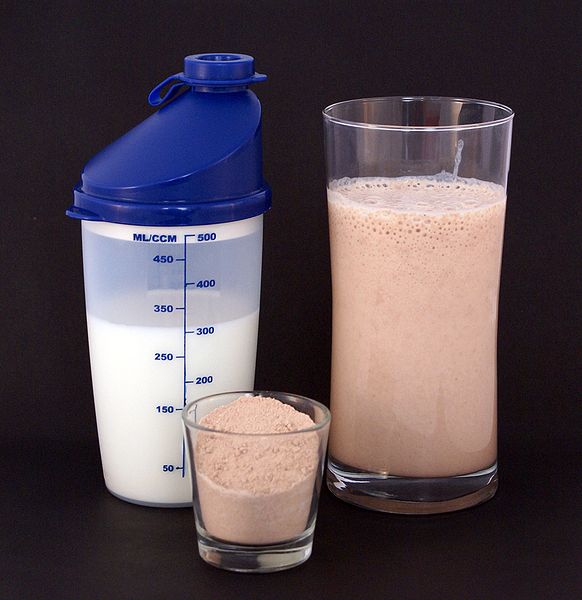Last Updated 3 years ago
Protein powder is soluble so it can be mixed with virtually any food or drink.
The back of virtually every protein powder pack will tell you “mixes great with 500mls of water” but this is rarely true.
Chances are it will taste like you’re choking down liquid cardboard – particularly if you’ve gone for an unflavoured product.
That said, try out your newly purchased protein powder with water and see how it tastes.
Why? Because by mixing just the protein powder with fresh water, you’re adding minimal calories whilst also increasing your protein intake for the day.

Alternatively, you can blend plain powders into milk or smoothies.
Cow’s milk will add a bit of carbohydrate and fat to your protein shake, and makes the consistency richer.
It’s also good if you’re trying to gain weight or are still growing.
Having your protein shake with milk also gives you an added source of natural protein and calcium, both of which are helpful when it comes to building muscles.
For vegans, and those who are lactose intolerant, almond milk or soy milk are two equally good alternatives.
Decide whether you want to bulk out and up your calorie-intake, or whether you want to shed some fat and use protein powder in meal replacement shakes.
Experiment with various concoctions and once you find a flavour and consistency that you like be sure to write it down. If you want to release your inner fitness nerd, consider what blend of macros you need to incorporate to fit in with your goals.
Bananas, strawberries and blueberries are perfect ways to add flavour and vitamins. Most supermarkets offer frozen berry medleys that are more cost efficient and minimise prep and wasteage.
Try blending in a handful of fresh or frozen spinach – you’ll be stunned at how little you can taste it (even though the colour can be off-putting).
Try using oat milk to go plant-based and get your B12, skimmed milk or whole milk to change up the consistency and calories, or even a low-sugar orange juice for a sweet kick.
Another way of getting some healthy calories in there is to throw in nut butter and some seeds like chia seeds or sunflower seeds.
Just remember that heathy calories are still calories, and it’s not hard to hit 600 or so calories in a few gulps.
If you can’t lose weight, it’s because you’re eating too many calories, so be aware of how many calories are going into your quickly-consumed protein shake.
If you want to use protein powder as part of a weight loss strategy, you may need to adjust your dieting strategy.
There are no set rules when it comes to combining protein powders with other ingredients so do whatever works for you and gets it into your diet at the right time of day.

Bake with it, sprinkle it in your coffee, stir it through your porridge, whatever takes your fancy.
If you need to get some protein into your morning meal, adding protein powder to your cereal is a quick and easy option.
Either sprinkle the powder over your cereal and stir to distribute evenly before adding milk, or prepare a protein shake in your shaker bottle and then pour over your chosen cereal choice.
Porridge or oatmeal is another good option. It is a healthy breakfast choice already, full of complex carbohydrates and fibre.
Stir in a serving of protein powder before cooking and then garnish with some blueberries or other fresh fruit.
If you’ve heard people saying you can’t cook with protein powder because it will become denatured or damaged, you can brush their advice right off.
Protein powders lose very little nutritional value when they are heated or cooked. So get stuck into your tray bakes, slices, breads, muffins and anything else you can think of!
Snacking on protein sources is one of the best ways to induce satiety in the body and thus aid weight loss goals.
Just remember that the body is only capable of absorbing so much protein in one go. So be sure to figure out how much protein you need based on your weight, height and gender.
There is such a thing as having too much protein and some powders contain up to 80 grams per serving, which is too much for most people.
Long-term excessive consumption of protein may damage the kidneys and liver and affect the body’s bone and calcium balance.

